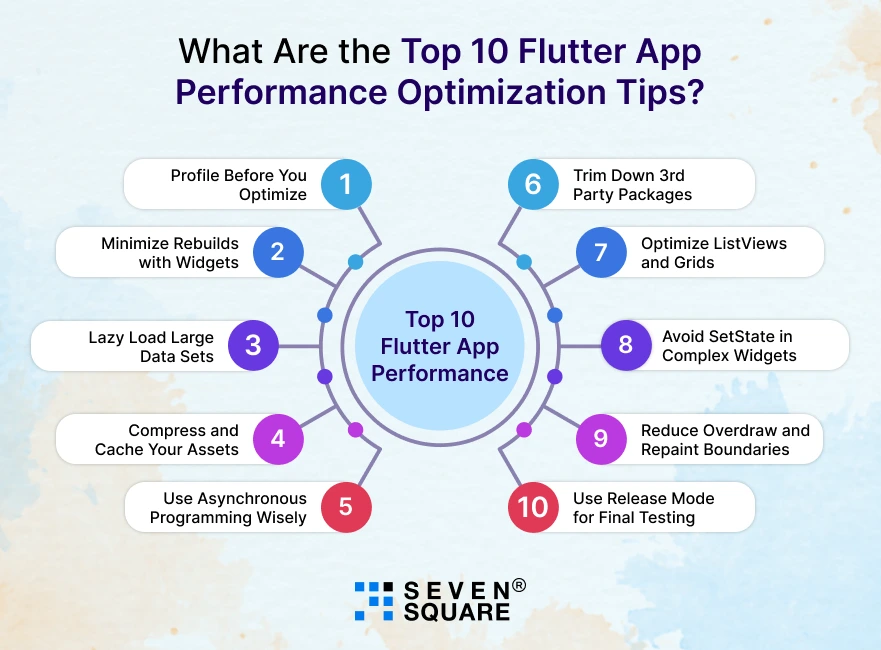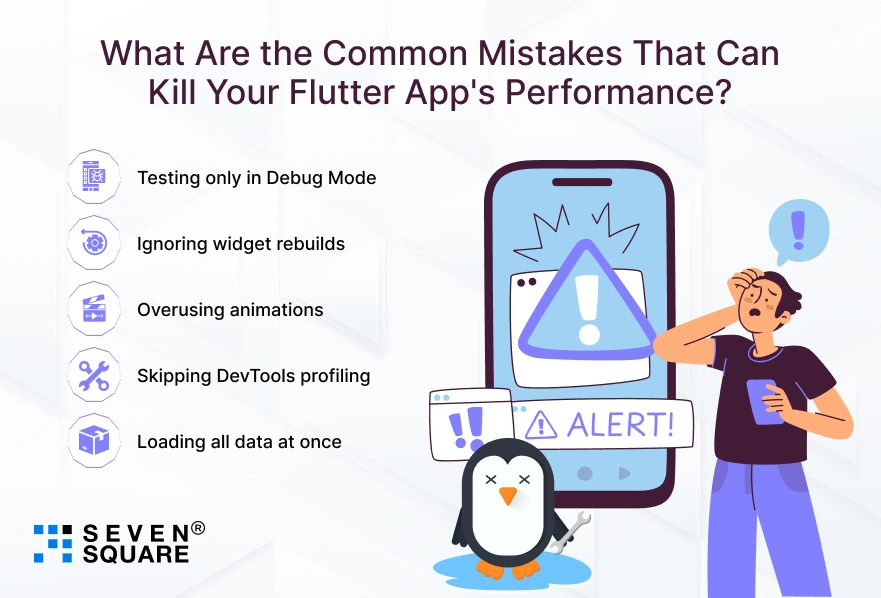Have you ever downloaded a beautifully designed Flutter app only to delete it minutes later because it lagged, crashed, or took forever to load?
Yeah, we’ve all been there.
And if you’re a founder, that’s your nightmare.
You’ve invested months into development. The UI is slick. The features are solid.
But users bounce because the app stutters on low-end devices or chews up too much memory.
At Seven Square, we’ve optimized Flutter apps across logistics, healthtech, ecommerce, fintech, and more.
We know how critical speed and responsiveness are to user retention.
And we’ve seen firsthand how Flutter app performance optimization can instantly boost reviews, retention, and even revenue.
This blog is all about Flutter app performance and ways to optimize Flutter app for best performance.
Here you can see the list of 10 battle-tested, real-world Flutter performance optimization techniques that we use for our clients.
What is Flutter & Why Performance Is a Dealbreaker?
Flutter is Google’s open-source UI toolkit for building natively compiled apps for mobile, web, and desktop all from a single codebase.
But here’s the thing: Even though Flutter is fast out of the box, it’s not immune to performance issues.
If your Flutter app lags, crashes, or loads slowly, users won’t blame the framework, they’ll blame your product.
Why performance matters:
- 53% of users abandon an app if it takes more than 3 seconds to load.
- App store reviews often cite “slow” as the reason for 1-star ratings.
- Lag impacts conversion especially in ecommerce, fintech, and real-time apps.
At Seven Square, we’ve seen well-built apps underperform simply because of avoidable performance pitfalls. Performance isn’t a nice-to-have. It’s a necessity for growth.
Inside Flutter: The 3 Core Components You Should Know
To understand how to optimize a Flutter app, you need to understand what’s under the hood.
Here are the three foundational layers of Flutter:
1. Framework Layer (Dart)
- This is where developers write their app’s logic and UI using Dart. It includes widgets, rendering, animation, and gesture libraries.
2. Engine Layer (C++)
- Handles rendering via Skia (graphics engine), text layout, plugin architecture, and more. It translates your Dart code into native calls.
3. Embedder Layer
- This is platform-specific (iOS, Android, etc.). It loads the Flutter engine and connects it to the OS (touch input, accessibility, app lifecycle).
Why it matters: When optimizing, you must know whether your issue is caused by Dart code (Framework), GPU overload (Engine), or device limitations (Embedder).
Understanding this breakdown helps you:
- Target the right fixes faster
- Use profiling tools effectively
- Communicate better with dev teams or tech partners
What Are the Top 10 Flutter App Performance Optimization Tips?

Here you can explore some of the best tips to optimize Flutter app so it can give top-notch performance.
1. Profile Before You Optimize (Use Flutter DevTools)
Before jumping into code changes, start by profiling your Flutter app performance using Flutter DevTools.
Why it matters: You can’t improve what you don’t measure. DevTools helps you visualize rendering times, CPU usage, memory leaks, and more.
This tool reveals the real bottlenecks.
Tip: Focus on the “Performance” tab to detect jank and slow frames. Look for dropped frames and memory spikes.
2. Minimize Rebuilds with Widgets
Flutter’s reactive model can be both a blessing and a curse. If you’re not careful, widgets rebuild unnecessarily, slowing down your UI.
Solution: Use const constructors where possible and break large widgets into smaller stateless ones. Monitor rebuilds using DevTools’ widget rebuild tracker.
3. Lazy Load Large Data Sets
If your app pulls in large image lists or database entries on the first screen, it’ll be slow. Really slow.
Do this instead: Implement lazy loading using ListView.builder, Pagination, or infinite_scroll_pagination package. Only load what the user sees.
Use case: We helped an edtech platform reduce their Flutter app lag by 60% just by deferring image loads until visible.
4. Compress and Cache Your Assets
Images and animations look great. But if not optimized, they will destroy your app speed.
Quick wins:
- Use WebP format for images.
- Use flutter_cache_manager to cache assets.
- Compress animation assets.
This is one of the best ways to speed up Flutter app startup time.
5. Use Asynchronous Programming Wisely
Flutter is single-threaded. Long operations on the main thread? That leads to jank.
Fix it with: Future, async/await, compute() for expensive tasks, and Isolates when needed.
We once saw a finance app hang for 3 seconds, a simple isolate fix made it buttery smooth.
6. Trim Down 3rd Party Packages
Tempted to install that cool-looking package? Think twice. Each dependency adds build time, increases app size, and can introduce memory leaks.
Solution: Use native code or minimal custom logic for small features. Evaluate every dependency’s performance overhead.
Our team reduced a 120MB ecommerce app to 82MB by dropping 6 unnecessary packages. Results? Faster loads, better UX.
7. Optimize ListViews and Grids
Flutter offers powerful list and grid widgets, but they can quickly get heavy if not optimized.
Performance tricks:
- Use ListView.builder, not ListView
- Use AutomaticKeepAliveClientMixin wisely
- Avoid nesting scrollables
8. Avoid SetState in Complex Widgets
Using setState() in large widgets causes entire trees to rebuild, which equals lag.
Use instead: State management solutions like Provider, Riverpod, or Bloc to manage state updates more surgically.
This is one of those Flutter optimization tips you can’t afford to ignore in large-scale apps.
9. Reduce Overdraw and Repaint Boundaries
Too many overlapping widgets or redraws will waste GPU power.
Tools:
- Enable “Debug Paint” and “Show Repaint Rainbow” in Flutter DevTools
- Add RepaintBoundary where applicable
Real-world result: We helped a delivery logistics client cut animation stutter by 40% on mid-range Android devices using just this technique
10.Use Release Mode for Final Testing
Developers often test performance in debug mode. Don’t. Flutter compiles differently in release mode, and the performance is significantly better.
Tip: Always build and test with flutter build apk –release or on TestFlight before shipping.
What Are the Common Mistakes That Can Kill Your Flutter App’s Performance?

Even the best teams overlook things. Here are common Flutter performance optimization mistakes we see again and again and how to avoid them:
- Testing only in Debug Mode: Debug mode is far from reality. Always use release mode to measure actual app behavior.
- Ignoring widget rebuilds: Too many setState() calls? You’re slowing your app down with unnecessary rebuilds.
- Overusing animations: Complex or unoptimized animations can cause noticeable UI jank. Keep them smooth and GPU-friendly.
- Skipping DevTools profiling: Without real metrics from Flutter DevTools performance, you’re just guessing what’s slow.
- Loading all data at once: Especially on home screens this leads to heavy first loads and increased bounce rates.
Avoiding these pitfalls alone can help reduce Flutter app lag and improve Flutter app speed instantly.
How Seven Square Builds Flutter Apps That Don’t Lag Ever?
At Seven Square, Flutter performance optimization is built into our development process.
From the first sprint to post-launch iterations, our team delivers apps that are fast, smooth, and scalable.
Here’s how we build Flutter apps that users love and founders trust:
Our Flutter Development Principles
- Performance-First Architecture: We design screens with build efficiency and rendering speed in mind—no widget overload, no frame drops.
- DevTools-Driven Debugging: Our engineers use Flutter DevTools performance insights regularly to analyze frame rendering, memory leaks, and CPU usage.
- Custom State Management Setup: We tailor state handling using Provider, Riverpod, or Bloc depending on app complexity to avoid the overuse of setState.
- Lean & Clean Codebase: We follow Flutter performance best practices, trimming unnecessary packages, compressing assets, and structuring code for minimal rebuilds.
- Device & OS Testing: We test on both low-end Androids and newer iPhones in release mode, not just emulators so users get the same snappy experience across the board.
Projects Where Optimization Delivered Real Wins
1. Warranty Bell: The client wanted a smooth UI experience for tracking product warranties across thousands of entries.
Our Solution:
- Used ListView.builder with pagination to lazy-load data.
- Implemented caching for network responses and assets.
- Reduced initial load time by 40%.
2. Self-Study: Slow scrolling and lag while accessing large study material libraries.
Our Solution:
- Used compute() for parsing heavy JSON.
- Integrated image caching and local DB sync.
- Achieved 99.5% crash-free sessions and faster content rendering.
3. IELTS App:UI lag during transitions, and large audio files slowing load time.
Our Solution:
- Compressed audio assets and used lazy loading for quizzes.
- Added RepaintBoundary to reduce redraws during transitions.
- Optimized app size and startup speed by removing unused packages.
Want a Fully Optimized Flutter App? Contact Us Now!
Don’t Let Performance Kill Your Product
Most users don’t care how beautiful your code is. They care if your app opens in a second. If it scrolls smoothly. If it just works.
These 10 Flutter performance optimization tips can be the difference between an app that gets deleted and one that wins loyal users.
So ask yourself: What small optimizations could deliver the biggest performance wins today?
Your users won’t thank you with words. They’ll thank you by sticking around longer.
FAQs
- To improve Flutter app performance on low-end devices, avoid heavy widgets, minimize third-party packages, lazy-load content using ListView.builder, compress images, and test in release mode.
- These Flutter performance optimization techniques make the app run smoother even on older hardware.
- Lag in Flutter apps often comes from unnecessary widget rebuilds, unoptimized animations, or blocking the main thread.
- Use Flutter DevTools performance to find bottlenecks, and apply best practices like isolating expensive operations, using const widgets, and caching assets to reduce Flutter app lag.
- To speed up Flutter app startup time, minimize initial data loads, compress assets, avoid unnecessary dependencies, and keep the first screen lightweight.
- Consider preloading only critical components and lazy-loading the rest post-launch.
- Yes, Flutter is capable of building high-performance apps if you follow best practices like optimizing widget usage, minimizing rebuilds, and leveraging async programming correctly.
- Many production-grade apps rely on Flutter performance optimization tips to meet enterprise-grade performance standards.